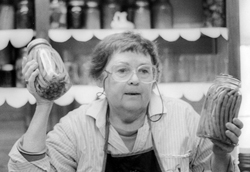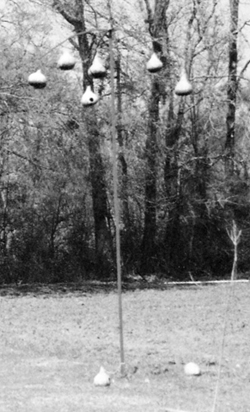Introduction to Delta Pieces: Northeast Louisiana Folklife
Map: Cultural Micro-Regions of the Delta, Northeast Louisiana

The Louisiana Delta: Land of Rivers








Ethnic Groups










Working in the Delta








Homemaking in the Delta



Worshiping in the Delta



Making Music in the Delta




Playing in the Delta







Telling Stories in the Delta



Delta Archival Materials
Bibliography

Making a Home in the Delta: Women and the Domestic Environment
By Deborah Boykin
In some areas of the Deep South, much of the landscape is still given over to growing things. Most of the land and much of the time and energy of the people—men and women—are given over to crops, whether cotton or catfish, soybeans or rice. Mile after mile of fields are punctuated by small towns with names like Delhi, Waterproof, Alligator, or Louise. Interminable plant rows or flat, shimmering catfish ponds extend from road to horizon. Turnrows—the lanes of hard-packed dirt where drivers turn cultivators or cotton pickers—are all that separate one field from another. The landscape is vast, symmetrical, and hypnotic. From the deep greens of summer to the browns and greys of harvest time, the fields change only with the seasons.
While the fields of the rural south offer little in the way of contrast, the same cannot be said for the lives and homes of its people. Wealth and poverty exist side by side, with very little middle ground. Planters whose elegant homes are surrounded by formal gardens may have neighbors who live in weathered frame houses with swept yards and tire planters. In small towns, only a few blocks separate carefully planned plantings and manicured lawns from cottage gardens where the aesthetic tends more toward riotous color and lush greenery. Still, there are similarities across class and race lines, and nowhere are they more evident than in the gardens, homes and kitchens of the rural South.
There are some distinctions to be drawn between gardens in town and those in the country, as well as the spaces created by Black gardeners and those by their White counterparts. Flower gardens in town neighborhoods are more likely to be formal, for instance, and confined to backyards. Other gardeners make use of any available space, including the porch. These are stylistic variations for the most part, though. The function of Southern gardens is much the same, no matter where they are planted.
For most people in the South, the garden is an extension of living space. Summer heat is completely democratic; sending planters, field workers, and merchants in search of shade and a cool breeze. In the days before air conditioning, they would all seek refuge in their gardens and on their porches. The variety of outdoor furniture in use throughout the South, from wrought iron to webbing, suggests that this tradition remains, even in places where air conditioning is the norm. The warmer months find many Southern families taking meals, sitting and visiting, or entertaining guests in their gardens and yards.
Southern gardens tend to be lush, tightly planted, and enclosed. Sometimes the enclosure is man-made, sometimes a clipped privet hedge. Even formal gardens may be surrounded by hairpin wire fencing or picket. Some fences are more eccentric, incorporating a variety of found materials. In any case, the purpose of the fencing is to enclose the space while allowing air to circulate. Gardenias, four o'clocks, honeysuckle and magnolias might be planted for fragrance in the late afternoon in evening when the family would be most likely to gather outside. Broad-leafed plants like elephant ears, cannas, and ginger may grow in beds alongside ferns and castor beans. Other plants are grown in containers, perhaps as a nod to the unpredictable weather of the region. A container can be moved under cover when there's too much rain or closer to a hose during a summer dry spell. It's likely, too, that southern gardeners use containers and other items – functional, decorative, or both – to create a space that reflects a personal aesthetic.
The more formal the garden, the more likely it is to see matching containers, such as urns made of molded concrete purchased half-barrels. Decorative features are usually functional as well, such as bird baths or stepping stones. Any lawn furniture is matched and usually made from painted wrought iron.
Other gardeners like to improvise. They create planters from old enamelware, paint buckets, or tires. They decorate their gardens with painted plywood figures, whirligigs, or painted rocks. In rural yards and gardens, larger, free-standing decorations may break the monotony of the landscape. Travelers on US Highway 61, for example, are often surprised to see several large, metal dinosaurs on the horizon as they approach Ergermont, Mississippi. They are the work of a local welder who made them "to give people something to look at when they drive through."
Many Southern women give as much thought to the aesthetics of their yards and garden spaces as they do to their homes, probably because for them, the two are inextricable. Wedding receptions, barbeques, family reunions, parties, or other social events in the south are likely to take place outdoors. And there is no shortage of social events in the south. Entertaining is considered an art form, and Southern women, both Black and White, absorb a complicated set of domestic customs and recipes from their relatives and neighbors as they grow up. Homemakers take pride in a tradition of hospitality that many see as having roots in plantation life.
Three cookbooks from the Delta region of Louisiana and Mississippi provide some insights. Gourmet of the Delta, first published in 1958, is collection of recipes prepared by the Women's Auxiliaries of St. John's Episcopal Church in Leland, Mississippi, and St. Paul's in nearby Hollandale. The introduction describes the Delta as a region settled
by the sons of wealthy planters of Virginia, Kentucky, Tennessee, and South Carolina. They came . . . to further their fortunes in a new land. From these landed, cultured people descend many of the present Delta inhabitants . . . . Many have known the hospitality and graciousness of Delta hostesses . . . . It is our hope . . .in compiling the recipes of our own and those of our many friends for discriminating hostesses everywhere that we, in our small way, will be the means of helping to preserve one of the traditions of the ‘Delta Way of Life.’
In 1972, the Junior Charity League of Monroe, Louisiana looked to similar roots in the introduction to The Cotton Country Collection:
The plantations along the river and the bayous were almost entirely self-sustaining, raising their own food, making their own clothes, building their homes from the materials in the forests. Plantation chatelaines and their cooks using the unusually lavish gifts of nature and the ideas of many root sources developed a style of cooking distinctive in its heritage and delicious in its own nature.
This tradition of hospitality transcends stereotypes of planter aristocracy and the "Old South." The women who worked in the fields and kitchens of the Delta also took pride in the tables they set. In The Soul of Southern Cooking, published in 1989, Kathy Starr offers the perspective of an African-American homemaker.
It was a must that simple foods make a delicious meal. My grandmamma, even today, can tell you stories of how proud she felt of her sister, Malinda, who could walk up out of the cotton field, find company sitting on her steps, take a shelf of nothing, and make the best meal you ever tasted. There's long tradition of making good food out of nothing in my family, who have lived in the Mississippi Delta since it was first cleared and settled for growing cotton.
The kitchens of the south, like the gardens, are similar in many respects. Women take pride in setting a generous table and have definite ideas about what's appropriate for a given type of meal. Table settings may vary according to custom or income, but whether a table is set with heirloom china or paper plates, there will be an abundance of food. Kathy Starr writes about her grandmother's Christmas dinners in Hollandale:
The holiday table is never considered complete if you can't fill up at least one separate table with food [including] baked turkey, baked duck, baked ham, dressing with giblet gravy, potato salad, cranberry sauce, chow-chow, mustard and turnip green, corn bread, yeast rolls, coconut cake, jelly cake, caramel cake, pecan pies, sweet potato pies, ambrosia, and fruit cake.
The women of St. Paul's Episcopal would agree. Their suggested menu for a Christmas dinner includes "baked turkey with oyster dressing, rice with giblet gravy, eggplant casserole, English peas, candied sweet potatoes, cranberry jelly, a tray of homemade pickles and relishes, and white fruit cake."
These women of different generations and races share similar attitudes about homemaking. Their gardens and kitchens are characterized by the appearance of abundance. Flower beds and planters are crowded with blooms, tables are loaded with food, decorative elements range from flower arrangements in formal living rooms to bottle trees in rural yards. Much of the social life in the south, from garden receptions to house parties to fish fries, is centered in the home and its outdoor spaces. Many of the traditions associated with homemaking the south may appear to have their roots in plantation stereotypes, but when foodways, gardening traditions, and the aesthetics of homemaking are compared across lines of class and race, common traits emerge. The lush gardens and decorated homes found around the South embody a need to create a personal space in an impersonal landscape. Homemaking traditions as conventions offer a predictable framework for a society in which much still depends on the unpredictability of nature.





